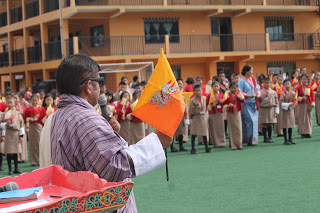Continue from yesterday's post.....
7.Troublesome youth: When his father, a minor Chieftain died, Genghis khan succeeded his father in his early teen. But the tribe didnt support him. Though they were temporarily abandoned but they left for some other safer place.
Zhabdrung had also succeeded his grandfather as the abode of Ralung Monastry in Tibet in his early teen but soon a dispute over the reincarnation of Pema Karpo, a Buddhist scholar, led him to flee from Tibet for Bhutan. Tsang leader supported Paksang Wangpo as the real reincarnation and they rejected the popular believe of the people that Zhabdrung was indeed the real incarnation. Thus the Fear of losing his life he makes an immediate exit for Bhutan.
8.Very religious yet tolerant to many religions: There was freedom of religion in the warlord’s Kingdom. The Great Genghis Khan gave everyone the right to choose their religion because his empire was so large that consisted people who followed all major religions.
In 1627, when two Portuguese Jesuits Fr. Casella and Fr. Cabral were on their way towards Tibet they met with Zhabdrung Rinpoche. Zhabdrung strongly encouraged them to stay and had even given them a room in Cheri Monastery to use it as a Chapel. They were allowed to preach the Christian faith to the locals which clearly indicates that he was an open minded person and someone who could tolerate other religions too.
9.Highly respected as the Founding Father: They are highly revered as the founding fathers of their nation. Genghis Khans mighty statue is built in honor of the Great leader. The statue is located on the bank of Tuul River some 54 km east of the Mongolian Capital Ulaanbaatar.
And coming back home, the dead remains of Zhabdrung Rinpoche is preserved in a secluded temple inside the Punakha Dzong and is visited by kings and lay men alike in times of joy and difficulties to receive blessings and wisdom.
When I was sharing this similarities with my history students one of them stood up to claim that Zhabdrung must have copied everything from Genghis Khan. I promptly replied, it could be also purely coincident because these two men lived in two different era. Mr. Khan in 13th century (1200s) and our Ngawang Namgyel during the 17th century (1600s).
A student at the back requested me to share the differences. I replied by saying that there are but a few differences. Genghis Khan is credited for killing approximately 40 million people and we don't have any record suggesting such brutal nature of Zhabdrung. In fact he always used his spiritual powers than military might to bring enemies at home under his control.
The other different is that Zhabdrung married only once and history points out that he was very loyal and caring husband. Because when he made up his mind to enter into permanent retreat he arranges a suitable husband for his wife so she is not left all alone. On the other hand, the Great Genghis Khan never respected the institution of marriage.
After conquering a state he would order his generals to bring the most beautiful women among the lot for him. This was a routine affair for the warlord. Thus he is also credited to have fathered many thousand children. One record suggest 36 million men from eastern Europe to eastern China trace their genes to one man: The Great Genghis Khan as their sole ancestor.
When the bell rang I still remember clearly that I reiterated the fact to the whole class that the discourse wasn't to compare the generals. They were great in their own rights and highly respected in their own countries. I said, ‘ …by no means I am comparing them but I am simply sharing with you all what appears to me as an interesting set of facts that depict striking similarities between the two Great Generals’.
Photographs courtesy: Concern copyright holders.

































